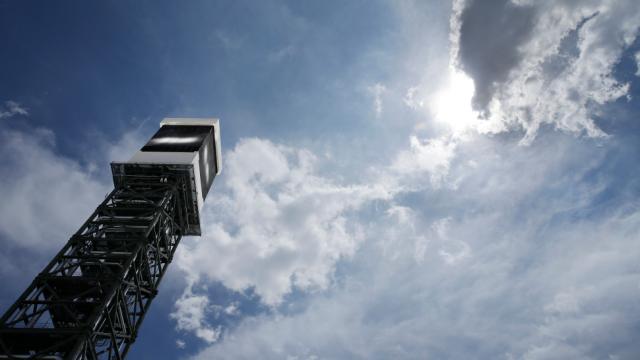Each year, around 6,000 birds are incinerated after chasing bugs within the Ivanpah concentrated solar thermal plant in the California Mojave Desert. Officials at the facility are enacting all sorts of measures to prevent this ongoing avian massacre — but it’s not clear if anything’s working.
A power tower at the Ivanpah Solar Electric Generating System. Each year, thousands of birds are incinerated when they fly too close. (Image: AP)
Workers at the plant call them “streamers”.
It’s when a bird has the misfortune of flying within the plant’s “flux field”, the blazingly hot region between the facility’s 13 square kilometres of mirrors and its three 40-storey towers. The birds, in search of a tasty meal, are instantly set ablaze, and then spiral to the ground like a World War II-era Messerschmitt downed by anti-aircraft fire. Federal biologists say that 6000 birds are killed each year in this gruesome manner — and that’s causing a serious headache for the plant’s owners.
Ivanpah’s bright lights attract insects, which in turn attracts the birds. It doesn’t help that the plant is located in the Mojave Desert, a critical refuge for birds migrating along the Pacific Flyway. But birds aren’t the only victims of this massive power plant; coyotes are feasting on road runners trapped along the outside of a perimeter fence that prevents protected tortoises from entering into the facility.
As Louis Sahagun reports in the Los Angeles Times, officials at the plant are working to prevent the bird incinerations. “We’re doing everything we can to reduce the number of birds killed out here,” noted plant spokesman David knox in the Times. To that end, plant workers have implemented a number of measures since the plant became operational in 2014, yet they describe the progress as “modest”.
Flood lights have been replaced with LED bulbs in an effort to attract fewer insects. Each tower has been fitted with a machine that emits a non-lethal respiratory irritant to prevent the birds from congregating. Anti-perching spikes have been installed on the tower’s frames. And speakers have been placed around the facility that broadcast recordings of loud, high-pitched shrieking noises. Such measures have proved helpful elsewhere, such as agricultural fields and commercial centres, but it’s not known if they will prove effective at a plant of this scope and type.

Image: AP
In the meantime, the streamers continue to litter the skies above the solar arrays. Critics, such as renewable energy project director Garry George, calls it a “cautionary tale” in the Times, adding that the plant “continues to operate as though there’s an endless supply of birds to burn”. The company is currently working with US state and federal regulators, but progress is being hampered by disputes about the exact numbers of birds killed within the plant. It may take another nine months or so before the true impact of Ivanpah’s new measures can be assessed.
This issue points to the sometimes uncomfortable consequences of technological innovation. The Ivanpah plant produces 390 megawatts of power, and it’s currently the world’s largest solar thermal power station. Yet this plant, which supposedly represents the future of solar power, is proving to be a menace to the local wildlife. Let’s hope the plant’s officials are able to come up with some truly meaningful measures to stop the carnage.
[LA Times]
